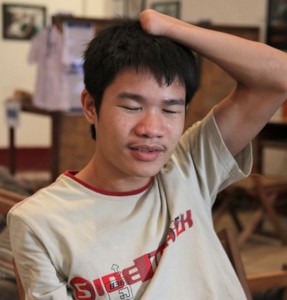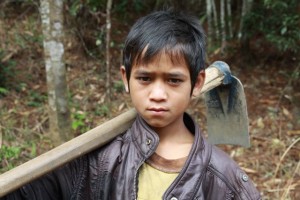Project Sekong 2012: Two boys each cross paths with a bombie.

As Pongsavath walked home from school a classmate handed him a forty-year-old cluster bomblet found along the road. The device exploded and destroyed his eyes and hands.
Report 17
My thoughts are with two boys here in Laos and the events that occurred when they crossed paths with unexploded ordnance. One boy was so gravely injured that from the day of his accident forward there has been no hope that he will ever resume his prior life. The other boy walked away from his encounter uninjured; the same son, brother, cousin, classmate, friend that he was when he left home earlier in the day. Was there a god looking down on the two boys when they each disturbed a sleeping bomb? The same god?
Pongsavath was walking home from high school with friends when one of his classmates spotted a cluster bomb along the roadway, the ball bearing filled device that people here call the “bombie”. After picking up the bomblet and inspecting it, the young man passed it to a friend who passed it to another. When the bomblet reached Pongsavath, it exploded.
That bomblet was the last thing Pongsavath will ever see with his eyes or touch with his hands. The blast destroyed his eyes. And traumatically amputated both hands.
Pongsavath survived the ordeal but his student days are over. His dreams are dead. Could his future be any bleaker? He only survives here through the kindness of family, friends and benefactors. Laos does not afford many opportunities for a blind, double amputee.

While helping his family turn soil over in an extension rice field Somsong hit a cluster bomblet with his hoe, hard enough to split the bomb in two. Somsong was lucky. The bomblet failed to detonate.
Yesterday, twelve-year-old Somsong could have, should have, met Pongsavath’s fate, or worse. His family grew impatient waiting for their extension rice field to be cleared of ordnance. By their reckoning, one more broken promise, one more delay, would mean one more growing season lost.
So…Somsong’s family disregarded warnings and began using their mattocks, shovels, picks and hoes to turn over the soil on the new field. Over several weeks, using hand tools alone, the family prepared more than two acres for planting and built an impressive series of stepped terraces to control the flow of water across the field.
The family knew they were aggressively disturbing uncleared land but were emboldened by the fact that not one, single piece of ordnance had yet turned up. They felt fortunate to own such safe land and began to feel a tad foolish for having delayed so long before starting work. Somsong’s father thought, “Maybe it isn’t necessary for villagers to delay starting projects like fishponds, gardens, and rice fields. Maybe the threat is exaggerated”.
Then, yesterday afternoon, Somsong’s father’s struck metal with his hoe. He explored further and cautiously excavated the tailfins from a bomb canister. The find gave him pause, but he continued work with his hoe. Minutes later, he found the seven-foot long canister itself, empty of any ordnance.
Eager to know what his discoveries might mean, the father headed to our camp, tailfins in hand. That was the man’s wise choice; his foolish choice was to permit his family to continue work in his absence.
Minutes after his father left for our camp, Somsong found the real deal. He brought his hoe down forcefully on a bomblet and heard the sharp ring of metal on metal. When he looked closely he discovered that he had squarely struck a bomblet and had somehow split it in two without detonating it.
The bombie didn’t explode. Somsong didn’t die in the field. He didn’t lose his hands and eyes. He didn’t lose his future. He didn’t become a life long burden to his family. Somsong was lucky; Pongsavath was not.
After we arrived on the scene, we cordoned off the area, divided the field into lanes, and began systematically searching for ordnance. Within hours our deminers had turned up two more life-threatening items: the fuse from a 500-pound bomb and nearby, another cluster bomblet.
Had we not found and destroyed those devices, someone in Somsong’s family surely would have struck them with a shovel or hoe. Would they have had Somsong’s rare, good luck? Or, would their names have joined those of 20,000 other Lao civilians who have been victims of old ordnance since the war ended nearly forty years ago?
